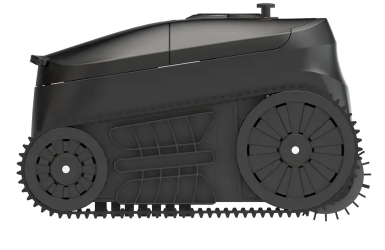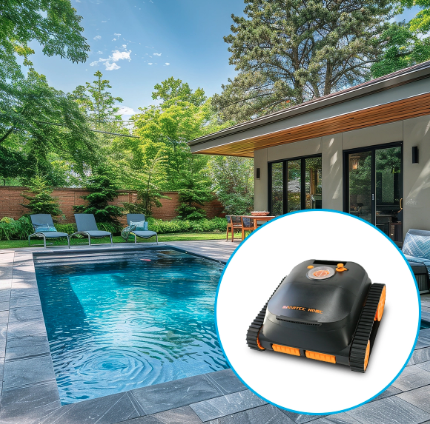Views: 0 Author: Site Editor Publish Time: 2025-09-17 Origin: Site











Robotic pool cleaners have revolutionized pool maintenance, making it easy to keep your swimming area clean without hours of manual work. From removing leaves and dirt to scrubbing walls and floors, these devices are designed to handle it all efficiently. However, like any high-tech equipment, proper care is essential to maximize lifespan and performance.
At Shandong Addotron Robotics Technology Co., Ltd., we specialize in advanced robotic pool cleaners built for reliability and efficiency. In this guide, we’ll explore the risks of leaving your robotic pool cleaner submerged, explain the effects of chemicals, sunlight, and water exposure, and provide practical maintenance and storage tips to help you protect your investment and enjoy a cleaner pool all year round.
Robotic pool cleaners are small, self-contained machines designed to navigate your pool automatically. They collect dirt, leaves, algae, and small debris without requiring manual effort. Most models are battery-powered, but some rely on the pool’s pump or water pressure.
They can climb walls and stairs automatically using built-in sensors.
Filters capture even fine particles, keeping water cleaner.
Smart navigation avoids obstacles and ensures full coverage.
| Type | Power Source | Features | Best For |
|---|---|---|---|
| Battery-powered | Rechargeable | Cordless, lightweight | Small-medium residential pools |
| Suction-side | Pool pump | Uses existing filtration | Pools with strong pumps |
| Pressure-side | Pool pump | Quick debris collection | Pools with leaves or heavy debris |
They are convenient, reduce manual cleaning, and can save water by reducing backwashing. However, efficiency depends on maintenance and smart usage habits.

Technically, a robotic pool cleaner can stay in the water without causing immediate damage. However, leaving it submerged for long periods carries several risks. Pool chemicals, constant sunlight, and floating debris can gradually degrade its components. Chlorine and other sanitizers may corrode the plastic, metal, and rubber parts, while continuous water exposure can wear down gaskets and seals. Prolonged exposure to UV rays can fade and weaken the outer shell, and debris or stray pool toys may obstruct its movement or even damage sensitive parts. Even occasional extended immersion can accelerate wear, so taking the cleaner out after each cycle is a small task that significantly improves its lifespan.
Pool chemicals maintain clean water but can harm robotic cleaners over time. Chlorine, bromine, and shock treatments can attack rubber seals and plastic exteriors. Unbalanced pH or high Total Alkalinity also increases corrosion risk.
Preventive Steps:
Test water chemistry before running the cleaner.
Avoid cleaning immediately after shocking or heavy chlorination.
Rinse thoroughly with fresh water after each use.
Inspect seals, wheels, and brushes regularly.
Tip: Even normal levels of chlorine slowly erode materials. Preventive care extends device life.
Even waterproof robots aren’t immune to long-term immersion. Seals, gaskets, and O-rings can deteriorate over time. Once compromised, water can enter electronics, causing motor failure or short circuits.
Maintenance Checklist:
Inspect seals and gaskets monthly.
Replace cracked or hardened components.
Dry robot completely after each use.
Avoid leaving robot in puddles or shallow pool areas between cycles.
Neglecting these steps often results in costly repairs or replacement.
Battery-powered cleaners are convenient, but batteries age faster when left submerged or improperly charged. Continuous chemical and water exposure, coupled with frequent use, shortens lifespan.
Battery Care Tips:
Follow manufacturer charging instructions.
Remove the robot when not in use.
Let batteries rest between cycles.
Store in moderate temperature; avoid extreme cold or heat.
| Task | Frequency |
|---|---|
| Charge per instructions | After each use |
| Remove robot from pool | After each cycle |
| Inspect battery for corrosion | Monthly |
| Rest battery | Between uses |
Proper battery management ensures stronger cleaning performance and longer overall lifespan.
UV rays can degrade plastic and rubber components over time. High heat may warp plastic, while freezing conditions can make it brittle.
Preventive Measures:
Store in shaded or covered locations when idle.
Use a pool cover to reduce direct sun exposure.
Consider indoor or climate-controlled storage during extreme temperatures.
Robotic cleaners rely on sensitive electronics. Water infiltration, power surges, or damaged cords can cause malfunctions or dangerous situations.
Safety Recommendations:
Use a surge protector for power supply.
Check cords and connectors regularly.
Ensure seals are intact before operation.
Keep electronics away from rain, puddles, or flooding.
Proper care prevents costly repairs and keeps swimmers safe.
Robots navigate small obstacles, but large debris, pool toys, or furniture can jam the machine. Hoses or cords may tangle swimmers.
Preventive Actions:
Remove large debris and toys before operation.
Only run robot when pool is empty.
Coil cords neatly to prevent tangling.
Tip: Even small items, like leaves or twigs, reduce cleaning efficiency and may overwork motors.

Keeping your robotic pool cleaner in top condition requires routine maintenance. After each use, it’s important to rinse the cleaner thoroughly to remove chemicals and debris. You should also empty and clean the filter bags or cartridges to ensure optimal suction and performance. Regularly inspecting brushes, wheels, and tracks helps spot wear early, while checking seals, gaskets, and cables prevents leaks and electrical issues.
Properly charging the battery and storing the cleaner in a dry, shaded area extends its lifespan, and updating the software ensures smooth navigation and efficient cleaning cycles. Finally, scheduling a professional inspection at least once a year can catch hidden problems and keep your cleaner running efficiently for years to come.
| Task | Frequency |
|---|---|
| Rinse after use | Every cleaning |
| Filter cleaning | Every cleaning |
| Seal inspection | Monthly |
| Battery check | Monthly |
| Professional servicing | Annually |
Following these routines prevents chemical, water, and mechanical damage.
Proper storage plays a key role in prolonging your robotic pool cleaner’s lifespan. Before putting it away, make sure the robot is completely dry to prevent moisture-related damage. Storing it in a cool, dry, and shaded location protects it from sunlight and extreme temperatures. Keeping the cleaner away from pests or rodents that might chew on wires or components is also important. Coiling cables loosely helps avoid kinks or tangles. Using storage caddies or boxes can make this process easier while keeping the robot safe. Even high - end models can degrade quickly if left in poor storage conditions for weeks or months.
Before storing your robotic pool cleaner, it’s crucial to ensure that it is completely dry. Any residual moisture can lead to mold, mildew, or even electrical issues over time. This step is particularly important if the robot has been used recently or if it has been exposed to rain or other damp conditions.
Before storage, it’s a good idea to perform a quick maintenance check. This includes cleaning any debris from the filters, brushes, and intake valves. Removing accumulated dirt and algae can prevent clogging and ensure the robot is ready for its next use.
Even high - end models can degrade quickly if left in poor storage conditions for weeks or months. Taking these extra steps can save you time and money in the long run. By following these storage recommendations, you can keep your robotic pool cleaner in optimal condition, ready to tackle the next pool cleaning task.
A: Yes, chlorine and unbalanced pH slowly corrode parts.
A: No, extended immersion accelerates wear and battery decline.
A: After every cleaning cycle to maintain suction and efficiency.
A: Yes, UV rays fade and crack plastic, weakening structure.
A: Usually yes; manufacturers require proper maintenance and storage.
While robotic pool cleaners offer incredible convenience, leaving one in the pool for extended periods carries real risks. Chemicals like chlorine, prolonged exposure to sunlight, constant water immersion, and floating debris can gradually degrade plastic, rubber, and electronic components. Over time, this wear can reduce cleaning efficiency, shorten battery life, and even cause costly repairs. By taking the extra few minutes to remove your cleaner after each cycle, rinse it thoroughly, inspect for damage, and store it in a cool, dry, and shaded area, you can protect your investment and ensure it continues to operate at peak performance. Proper care not only extends the life of the device but also keeps your pool safe, clean, and sparkling for swimmers year-round.